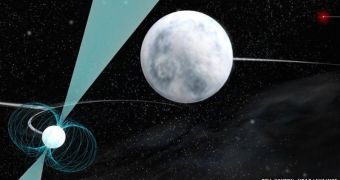At a conference held earlier in January, at the 223rd meeting of the American Astronomical Society (AAS), in Washington DC, astronomers at the National Radio Astronomy Observatory (NRAO) announced the discovery of a pulsar within a triple star system, a finding that could help experts test the tenets of Albert Einstein's theory of general relativity.
A paper detailing the findings, published in a recent issue of the top journal Nature, reveals that the pulsar in question has clock-like properties that could come in handy for studying gravitational interactions between the three stars. Experts will be able to test observable behaviors versus theoretical predictions, and see if the framework holds.
The millisecond pulsar was dubbed PSR J0337+1715. According to observations carried out with the NRAO Green Bank Telescope (GBT), the star spins around its axis a total of 366 times per second, emitting beams of radiation with each spin. This gives it the appearance of a cosmic lighthouse.
PSR J0337+1715 is a binary system with a white dwarf companion, which orbits it once every 1.6 days. A red giant orbits the system's center of gravity, but farther away than the two, as this video will confirm. All three stars fit in an orbit smaller than one astronomical unit, the mean Earth-Sun distance.
The trio is located less than 4,200 light-years away from Earth, which basically puts it in our cosmic backyard, and allows for in-depth observations to be conducted with a large number of telescopes.
According to NRAO investigator Scott Ransom, this triple star system makes up the perfect laboratory for studying the strong equivalence principle of Einstein’s main theory. Under such extreme conditions, it is entirely possible that the theoretical framework breaks apart, and physicists are interested in seeing how and why that happens, Earth Sky reports.
“For a time we were observing this pulsar every single day, just so we could make sense of the complicated way in which it was moving around its two companion stars,” commented astronomer Jason Hessels, who was the leader of observations carried out with the ASTRON Westerbork Synthesis Radio Telescope, in the Netherlands.
Additional data for this study were collected using the Arecibo radio telescope, in Puerto Rico, the largest single-dish radio observatory in the world.

 14 DAY TRIAL //
14 DAY TRIAL //